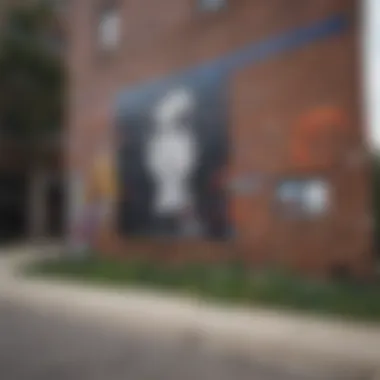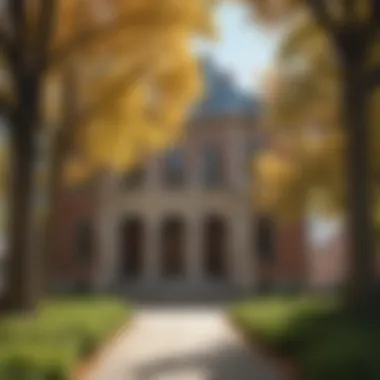Discovering Columbia: Chicago's Creative Design Hub


Intro
Columbia College Chicago stands as a pivotal institution in the landscape of design and culture. Founded in 1890, it has evolved into a significant hub for various artistic disciplines, particularly in fields such as architecture, visual arts, and performing arts. Its impact on urban culture is profound, influencing not only its students and alumni but also the city of Chicago itself.
The college’s approach to education goes beyond traditional methods. It incorporates practical experience with academic rigor, making it a unique environment for creative minds. This article delves into the intricate relationship between Columbia College and the fabric of Chicago, exploring its architectural influence and educational contributions.
Home Design Inspiration
The architectural identity of Columbia College Chicago reflects the dynamic character of the city. Here, we explore the elements that contribute to the college’s role in shaping contemporary home design inspirations.
Architectural Styles
Columbia showcases a variety of architectural styles, integrating both modern and historical influences. Notable styles include:
- Modernism: Emphasizes clean lines and functional spaces, often featuring large windows and open layouts. Buildings such as the Columbia College’s Media Production Center exemplify this style.
- Postmodernism: Combines traditional elements with contemporary designs. The campus features structures that exhibit this blend, inviting critical discussions about aesthetics and function.
- Sustainable Architecture: A recent focus in design, promoting eco-friendly building practices and materials. The college encourages students to engage with sustainable methods, reflecting global trends.
Innovative Decor Trends
In conjunction with the architectural styles, innovative decor trends have emerged from the creative energy of Columbia. Key trends include:
- Repurposed Materials: Students often explore the use of reclaimed wood and vintage furnishings, adding character to spaces with environmental consciousness.
- Minimalist Aesthetics: Emphasizing simplicity and decluttered spaces, this trend resonates with students seeking tranquility in their learning environments.
- Artistic Expression: The blending of art with everyday living spaces is a hallmark, showcasing student artworks in informal gallery settings throughout the college.
"Columbia College fosters an environment where creativity flourishes, influencing broader design trends beyond the classroom."
Stunning Locations
The context in which Columbia exists is enriched by its surroundings. The integration of art into urban spaces highlights the city’s commitment to culture and design.
Top Global Destinations
Chicago, home to Columbia, is filled with stunning locations that serve as inspirations for students and designers alike. Some noteworthy destinations include:
- Millennium Park: A quintessential urban park where architecture meets art.
- The Art Institute of Chicago: A treasure trove of art collections that continues to inspire.
Hidden Gems Around the World
Beyond Chicago, there are unique locations that influence design thinking globally:
- La Sagrada Familia, Barcelona: Gaudi’s masterpiece stands as a testament to imaginative architecture.
- Villa Savoye, France: A representation of modernist principles.
Through the synergy of Columbia College’s educational practices and the rich cultural landscape of Chicago, the exploration of design and architecture continues to thrive. The college plays a crucial role in not only shaping the architectural dialogue in Chicago but also in nurturing the designers of tomorrow.
Preamble to Columbia, Chicago,
Columbia, Chicago, represents a unique merging of educational institutions and urban culture. This section will underline the significance of Columbia in the broader context of design and culture, aiming to engage readers who seek a deeper understanding of the area’s influence. Columbia College Chicago serves as a vital part of the city’s architectural and cultural landscape. Its contributions extend beyond education to impact local art scenes and urban design practices.
Overview of Columbia College Chicago


Columbia College Chicago is a prominent higher education institution focused on the arts and communication. It attracts diverse students from various backgrounds. The college prides itself on a curriculum that blends creative and analytical skills. Programs range from film to fashion and graphic design, emphasizing hands-on experience. This practical approach to education empowers students to develop portfolios that are essential for careers in the competitive creative landscape. The school’s urban setting is a significant advantage, allowing students to immerse themselves in Chicago’s rich cultural environment. This connection to the city fosters opportunities for internships and collaborative projects.
Historical Development of Columbia
The evolution of Columbia College Chicago is marked by significant milestones. Founded in 1890, the institution initially focused on music and art. Over time, it expanded to include a wider array of creative disciplines. The growth reflects wider trends in art education during the 20th century.
Columbia’s adaptation to changing educational needs demonstrates its resilience. It has consistently strived to remain relevant in a continually evolving artistic and economic landscape. The expansion of programs and facilities has mirrored the artistic movements in Chicago and beyond, reinforcing the college’s role as a leader in creative education.
"Columbia College Chicago not only educates students but also contributes to the city's cultural richness and artistic identity."
The Architectural Significance of Columbia
The architectural significance of Columbia in Chicago resonates beyond mere aesthetics. It embodies a fusion of education, culture, and community engagement that is palpable in both the structures and the environment around it. Columbia College Chicago is not just an educational institution but a vibrant hub where design thinking and innovation thrive. The architecture reflects the diverse influences of its programs, as well as its commitment to nurturing creativity. Exploring these elements unveils the vital role Columbia plays in shaping both the urban landscape of Chicago and the ambitions of its students.
Notable Architectural Features
Columbia showcases various architectural features, each contributing uniquely to its identity. The campus is marked by a blend of historical and contemporary styles that signify the evolution of design. The following are key features:
- The Studio 404, a design and media space tailored for students in visual arts and design disciplines. Its modern facade and flexible interior allow for interactive learning.
- The Dance Center, designed with specific acoustic considerations and adaptable rehearsal space, emphasizing Columbia's dedication to performing arts.
- The library, which serves as a hub for research and collaboration. Its open spaces foster interaction, allowing students across various disciplines to converge and share ideas.
These architectural elements are not only functional but also foster creativity and collaboration, essential to the educational experience.
Influential Architects Associated with Columbia
Columbia's architectural narrative is intertwined with the influence of notable architects who have contributed to its physical growth. These individuals have shaped the spaces that define the campus. Some key architects include:
- David Adjaye, known for his commitment to social justice through architecture. His designs prioritize community engagement and have made a lasting impact on the inclusive atmosphere at Columbia.
- Meganom, a firm recognized for its contemporary approach to urban design. Their projects focus on how architecture can influence public life and community interaction.
- RTKL Associates, who have helped in designing spaces that enhance the artistic endeavors of students.
The contributions of these architects help underscore Columbia's role as a cutting-edge educational leader in design and culture.
Sustainability in Design Practices
Sustainability forms a cornerstone of Columbia's architectural philosophy. Recognizing the importance of environmental stewardship, Columbia engages in design practices that prioritize ecological responsibility. Several initiatives illustrate this commitment:
- The incorporation of green roofs and solar panels on various buildings aims to reduce carbon footprints.
- Emphasis on natural lighting and energy-efficient systems in construction highlights their proactive stance on energy conservation.
- Partnerships with organizations like the Chicago Architecture Foundation enhance awareness and application of sustainable practices within the urban context.
Through these practices, Columbia not only enriches its educational environment but also serves as a model for future architectural endeavors in Chicago and beyond.
Columbia's architecture represents a dynamic interaction of education, sustainability, and cultural richness, setting an example for future urban developments.
As Columbia continues to evolve, its architectural significance will undoubtedly expand, offering new insights and directions for integrating design and urban life.
Educational Contributions to Design
The significance of educational contributions to design is paramount in understanding Columbia's role within Chicago's cultural framework. As a prominent institution, Columbia College Chicago not only serves to educate future designers, artists, and cultural leaders but also shapes the very fabric of urban creativity. This aspect of Columbia is not merely an academic endeavor; it is a proactive commitment towards the development of skills, collaborative practices, and innovative thinking that resonates throughout the local and national design scenes.
One of the key elements leading to Columbia's prominence is the breadth of programs offered by the college, which cater to diverse interests and fields within design.
Programs Offered by Columbia


Columbia offers a wide range of programs in the arts and design, encompassing areas such as graphic design, fashion design, interior architecture, and multimedia arts. Each program is designed to equip students not only with technical skills but also with critical thinking and problem-solving abilities crucial for success in these competitive fields.
Students can engage in hands-on learning experiences, allowing them to experiment and refine their artistic vision. Collaborations with industry professionals ensure that the curriculum remains relevant and responsive to contemporary needs. [Disciplines and programs include:]
- Graphic Design
- Fashion Design
- Interior Architecture
- Photography
Through these programs, students participate in real-world projects, gaining insights that enhance their portfolios and professional readiness. The opportunity to work on assignments that engage with both local and international clients fosters an understanding of market demands and client relationships.
Impact of Digital Media and Technology
In today’s digital age, the impact of digital media and technology on design cannot be overstated. Columbia acknowledges this shift by integrating technology into its programs, providing students with essential tools to navigate and excel in a changing landscape. Students learn software applications used in design processes, ranging from Adobe Creative Suite to emerging technologies like 3D modeling and virtual reality.
This emphasis on digital competency stimulates innovative approaches. For instance, students are encouraged to incorporate elements of interactive design into their work. The ability to adapt to new technologies allows graduates to meet the evolving demands of the workplace effectively.
Collaboration with Industry Leaders
The emphasis on collaboration with industry leaders creates an enriching environment for students. Columbia’s connections with local businesses, non-profits, and creative organizations underscore its role not just as an educational institution but as a vital part of the design ecosystem.
Students often engage in internships and cooperative education placements that provide practical experiences. These collaborations lead to internships at renowned firms, enabling students to apply their skills in real-world situations. Furthermore, the college regularly invites professionals for workshops, critiques, and guest lectures, enhancing students’ exposure to current industry practices.
In summary, Columbia College Chicago maintains a crucial role in shaping the landscape of design education. Its comprehensive offerings, commitment to digital media, and strategic partnerships empower future generations of designers, ensuring that Columbia remains at the forefront of innovation and creativity.
Columbia's Role in the Chicago Cultural Landscape
Columbia College Chicago serves as a vital component in the cultural fabric of Chicago. Its role transcends mere educational functions. The institution contributes to the city’s identity, fostering creativity, innovation, and an appreciation for the arts. This section examines three key elements that illustrate Columbia's influence: cultural events and initiatives, partnerships with local organizations, and its impact on local art scenes.
Cultural Events and Initiatives
Columbia College Chicago organizes a myriad of cultural events and initiatives throughout the year. These activities highlight student creativity and engage the broader Chicago community. Events such as Columbia College's Film Festivals and Art and Design Exhibitions showcase the talent of emerging artists and designers.
The annual Transmedia Festival is particularly noteworthy. This event focuses on cutting-edge topics in technology and storytelling, attracting creators from various backgrounds. Additionally, Columbia actively participates in the city's larger Chicago Artists Month, which celebrates local talent and creativity. Through these initiatives, Columbia not just supports its students but also enhances the cultural landscape of Chicago.
Partnerships with Local Organizations
Columbia College Chicago collaborates with various local organizations to promote arts and education. These partnerships bridge the gap between academia and community, fostering a sense of shared purpose. Notable collaborations include working with the Chicago Cultural Center and The Museum of Contemporary Art. These institutions provide platforms for Columbia students to present their work, gaining invaluable exposure.
Furthermore, Columbia participates in community outreach through programs like Columbia Links. This initiative connects students with high school students, providing mentorship and encouraging engagement with media studies. Such partnerships enrich both the students and the local community, creating an ecosystem of creativity and education.
Influence on Local Art Scenes
The influence of Columbia on local art scenes is profound. The college's programs span various disciplines, including visual arts, fashion, music, and film. Graduates from Columbia often become key figures in Chicago's artistic community. Their contributions enrich the city’s cultural discourse.
An example can be found in the flourishing scene of independent filmmakers. Many successful filmmakers trace their roots back to Columbia, demonstrating the enduring impact of its educational approach. Faculty members, who are often active professionals in their fields, guide students to explore innovative ideas and visual narratives.
Columbia's emphasis on interdisciplinary studies has enabled students to blend different art forms, creating fresh and unique works that capture the essence of contemporary Chicago.
The Urban Environment and Columbia
The intersection of Columbia College Chicago and its urban environment forms a dynamic tapestry that actively shapes both institutional identity and community engagement. Understanding this relationship is crucial, as it reveals not just the character of Columbia but also highlights the role it plays within the greater urban landscape of Chicago. The design and accessibility considerations of the area enhance the overall experience for students, faculty, and visitors alike.


Integration of Green Spaces
Green spaces around Columbia foster a sense of community and well-being. Parks and gardens act as essential breathing spaces within the bustling city. These areas provide students with opportunities to relax, study, or engage in group activities. Significant landscapes, such as Grant Park, offer a visual and recreational respite from the urban intensity. The integration of landscaped areas aligns with a growing trend in urban design that emphasizes the importance of nature in city living.
The access to green areas also underlines the commitment of Columbia to promote sustainability and environmental awareness. Collaborations with local environmental organizations have led to initiatives aimed at enhancing these green spaces. Students often participate in community service projects, taking part in the upkeep and improvement of these vital environments.
Transportation Accessibility
Transportation plays a critical role in connecting Columbia to the broader fabric of Chicago. The college's location is strategically positioned near multiple public transport options, including bus and train lines. This connectivity is essential for students commuting from various neighborhoods.
Moreover, Columbia’s proximity to major thoroughfares allows for easy access to downtown Chicago and surrounding areas. This accessibility enhances not only the educational experience but also promotes a vibrant urban lifestyle. The integration of bike lanes and pedestrian-friendly pathways further supports sustainable transportation choices among students.
Overall, Columbia’s urban environment illustrates an intentional design that prioritizes green living and efficient transit, enhancing the quality of life for everyone involved.
Future Directions for Columbia
The future of Columbia College Chicago holds substantial importance within the context of design and cultural evolution in the city. As the institution navigates through the demands of modern education and community engagement, its role is becoming more pronounced. Emphasizing innovation, collaboration, and sustainability, Columbia is poised to impact not just the academic environment but also the broader community in meaningful ways. This section addresses emerging strategies and the potential benefits these initiatives might deliver.
Innovative Approaches in Education
In an age where education must adapt to rapid technological advancements, Columbia College Chicago is rethinking its approach. Innovative educational strategies are essential to prepare students for a constantly evolving job market. These methodologies often involve
- Incorporating hands-on learning experiences
- Utilizing immersive technology, such as virtual reality
- Fostering interdisciplinary collaboration among diverse fields of study
Such approaches enrich the curriculum by allowing students to engage with real-world challenges. For example, design students may work with technology students to create interactive art installations. This not only enhances technical skills but also nurtures critical thinking and creative problem-solving.
Another focus is the enhancement of online and hybrid learning models. By integrating these models, Columbia aims to serve a broader range of students, including those who may need flexibility due to work or family commitments. Online platforms also facilitate collaboration among students from different locations, enriching the educational experience.
Developments in Community Engagement
Community engagement is a core element of Columbia's future direction. The institution's commitment to connecting with local audiences presents a multitude of opportunities. Active community involvement not only fosters strong neighborhood ties but also ensures that students apply their learning in ways that matter to their surroundings.
Columbia engages in various programs aimed at uplifting and supporting the local community. These programs often include:
- Art installations in public spaces
- Workshops and seminars for residents
- Collaborations with local organizations for events
By actively participating in the community, Columbia not only provides valuable resources to residents but also enhances the practical education of its students. Such engagement develops a sense of responsibility and leadership, key attributes in today's professionals. Moreover, it amplifies the visibility of Columbia, positioning it as a key player in Chicago's cultural landscape.
"In community engagement, we recognize the symbiotic relationship between education and community development. It is crucial for our students to understand their role in contributing to the society around them."
Culmination
The significance of Columbia, Chicago, IL, unfolds through its multifaceted contributions to design, education, and culture. As examined throughout this article, Columbia serves not just as an academic institution but as a vital player in the urban fabric of Chicago. It influences the architectural landscape and fosters a culture of innovation and creativity that ripples through the city.
Summary of Insights
Columbia's architectural footprint highlights the synthesis of art and functionality. The interplay between modern design and sustainable practices is evident in its buildings. Educational programs cater to diverse aspects of design, empowering students to utilize technology effectively. The partnerships with local organizations further integrate Columbia into the community, strengthening local art scenes. In essence, the institution reflects and shapes Chicago's cultural identity.
Final Thoughts on Columbia's Impact
Columbia’s role extends beyond education. It cultivates an environment where creativity flourishes. The initiatives undertaken by Columbia signify a commitment to social and environmental responsibility. This embraces an evolving relationship between design and the city's needs. Thus, Columbia, Chicago, not only educates future designers but is also a cornerstone for Chicago's cultural progression.
Columbia stands as a beacon for design thinking, pushing the boundaries of creativity while maintaining a firm groundedness in community values.
Through ongoing developments, the institution will likely continue its trajectory of transforming and enriching Chicago's cultural landscape.







